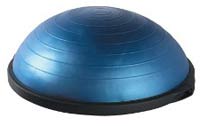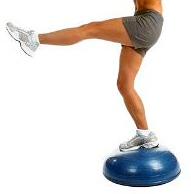- Like
- SHARE
- Digg
- Del
- Tumblr
- VKontakte
- Flattr
- Buffer
- Love This
- Save
- Odnoklassniki
- Meneame
- Blogger
- Amazon
- Yahoo Mail
- Gmail
- AOL
- Newsvine
- HackerNews
- Evernote
- MySpace
- Mail.ru
- Viadeo
- Line
- Comments
- Yummly
- SMS
- Viber
- Telegram
- JOIN
- Skype
- Facebook Messenger
- Kakao
- LiveJournal
- Yammer
- Edgar
- Fintel
- Mix
- Instapaper
- Copy Link
Health and Fitness Benefits of Balance Training Exercises
 Why is Balance Important?
Why is Balance Important?
All functional movements, from walking down the street, to dancing, to properly executing a squat, require a working balance system. A basic definition of balance is the body being in a still state of equilibrium. Even more important is dynamic balance, in which the body moves and changes directions in an agile, skilled way without falling over.
Balance may be taken for granted as you go about your exercise routine; however, it’s a mistake to neglect training your balance mechanisms! Suboptimal balance puts you at increased risk of hurting yourself, as well as the development of muscle imbalances which affect your posture, putting you smack-dab in the cumulative injury cycle.
In addition to the balance training modalities described in this article, activities such as yoga and tai chi provide built-in balance training among myriad other benefits. The key is to find balance training workouts that are enjoyable and effective for you.
What Types of Equipment are Used in Balance Training?

Some balance exercises are done on the ground with no equipment at all. Other exercises may require simple equipment to further challenge your balance, such as half foam rolls, small
balance beams, balance disks, wobble boards, and BOSU balls. Many of these implements come in different sizes and materials to provide a progressive challenge.
Most gyms have this type of equipment on hand, or you can buy balance training equipment online if you prefer to train at home.
Who Should Add Balance Training to Their Workouts?
Balance training is important when you begin working out, as it helps greatly in joint stabilization and developing coordination. Balance is also important as you progress into the more advanced strength levels of training; the exercises become more demanding on your neuromuscular system, and your body needs to have a trained balance mechanism to keep up. Additionally, advanced exercisers benefit from balance training due to the performance enhancements optimal balance offers.
Everyone can benefit from balance training exercises; I encourage everyone from casual exercisers, runners, dancers, martial artists, and athletes of all other types to integrate balance exercises into their workout regimen.
What Health and Fitness Benefits Does Balance Training Offer?
An excellent benefit provided by balance training is joint stabilization. Stabilization of joints involves training the strength of muscles themselves as well as training the sensory receptors in the nervous system that give your brain information about your body position. More refined information from these receptors decreases the chance of injury due to improper joint motion.
Joint dysfunction is a major cause of lower back injuries, which affect 80% of the adult U.S. population. The more we can do to prevent joint dysfunction, the better.
Balance training increases your coordination and kinesthetic awareness, allowing you to have more conscious control of your movements, as well as training your reflexive system to respond more appropriately to changing conditions without your having to think about it. This leads to increases in fitness and athletic performance.
In older adults, balance training helps prevent falls which are a common cause of injury. The American College of Sports Medicine recommends that both active and inactive older adults perform balance training at least three days a week.
What are the Characteristics of an Effective Balance Training Program?
Balance training exercises should challenge your limit of stability, or the distance outside your center of gravity you can move without falling over. Your limit of stability will become wider the more you train your balance. A good balance training program is progressive. You will want to start with easier exercises, and then move on to more difficult exercises as your balance improves over time. Don’t push too fast, or you may experience setbacks in the form of injury.
You should aim for controlled instability in your balance training sessions. This can mean employing simple equipment meant to provide a progressive challenge. For example, you begin a certain exercise on the floor, then as you improve in subsequent sessions, you may graduate to a balance beam or half foam roll, then onto a balance disk, then a BOSU ball, and onward.
How Does Balance Training Fit into a Workout Session?
Balance training exercises are appropriate at various points throughout your workout. Consider the following suggestions and see what works best for you.
The National Academy of Sports Medicine (NASM) recommends doing balance exercises after your warm-up, but before the tougher part of your workout such as strength training. However, a recent study of soccer athletes showed more improvement in the balance of those performing balance exercises after their workout versus those who did balance exercises before working out.
The key is to DO the exercises, and do them regularly, whether you prefer to do them right after your warm-up or just before your cool-down. For maximum benefits, perform your sequence of balance exercises for 10 minutes three or four times per week for at least four weeks.
What are Some Effective Exercises to Train Balance?
Balance exercises range from very simple for beginners, to more complex for folks with more training. Here are just a few examples of balance exercises for beginning, intermediate, and advanced levels.
Beginners Balance Training Exercise: Single Leg Stance Variations
Standing in a neutral position with hands on hips, lift one leg in front of you as high as can be controlled. Hold here for a few seconds, then without letting the foot touch the ground, bring it back to center, then out to the side as high as can be controlled. Again, hold here for a few seconds, then bring the leg back to center, and then extend behind you. Hold for a few seconds and then repeat the whole sequence from the beginning.
Switch legs and repeat.
TIP: Contract the glutes of the leg you’re balancing on to stabilize.
This exercise can be progressed by balancing on a balance disk, the flat side of a half foam roll, or other piece of equipment.
Intermediate Balance Training Exercise: Single-Leg Squat Touchdown
From a neutral position with feet and hips pointing straight ahead, lift one leg. Slowly squat down as if you’re going to sit in a chair. Without letting the lifted foot touch the floor, reach down with the hand on the same side as the lifted foot and touch the floor or the balance foot. Stand up using your glutes and abs. Without letting the foot touch down, repeat a few more times.
Switch legs and repeat.
TIP: Focus on stability and optimal posture! Don’t let the knee cave in or bow out. If you find you can’t keep your knee from caving in, you need to focus on correcting the muscle imbalances likely at fault. Consult a personal trainer.
Advanced Balance Training Exercise: Single Leg Hop with Stabilization
This advanced balance exercise should only be attempted by folks with properly stabilized ankles and knees.
Standing in a neutral position with hands on hips, lift one knee to up to a 90-degree angle. Hop forward, landing on the opposite foot and stabilizing for 5 seconds. Hop back onto the opposite foot, landing and stabilizing for 5 seconds again. You can also hop from side to side, or try rotating on a diagonal for more of a challenge.
Switch feet and repeat.
TIP: Focus on a soft landing, distributing forces evenly to avoid stressing the joints too much. Keep your knee aligned over top of the second and third toes; don’t let in cave in or bow out.
Final Thoughts
Build a better, more integrated workout program by integrating balance training into your routine. Consult a physician if you find you struggle with balance, as several health conditions can lead to balance impairments. Enlist the help of a personal trainer to receive a workout plan tailored to your specific goals.
Click here to buy balance training equipment to use at home!
Balance Training Exercises: References
1. Clark, M.A., Lucett, S.C., and Sutton, B.G., (Eds.). (2012). Balance training concepts. NASM essentials of personal fitness training (4th ed). Philadelphia: Lippincott Williams & Wilkins.
2. Gioftsidou, A., et al. (2006). The effects of soccer training and timing of balance training on balance ability. European Journal of Applied Physiology, 96(6): 659-664.
3. Heyward, V. (2010). Designing balance training programs. Advanced Fitness Assessment and Exercise Prescription (6th ed.). Human Kinetics.
See Also:
About Mae Barraclough
Mae Barraclough, B.S., NASM-CPT, NASM-CES is a certified personal trainer, corrective exercise specialist, and licensed Zumba Instructor. With her passion for health, fitness, and dance, Mae loves learning all she can and sharing her knowledge with others.

